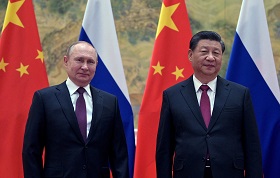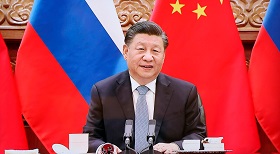Given the rapidly developing situation in Ukraine and the sweeping sanctions aimed at derailing Russia’s economy, Moscow has been mulling over its opportunities of making another pivot to the so-called Global East. Most of the Asia-Pacific forms an integral part of the mentioned area. The goal of this piece is to determine the tendencies intrinsic to this shift in Russian foreign policy and evaluate Russia’s resources in this direction, specifically focusing on the role of Russia-China “no limits” partnership.
On the conceptual level, neither Russia nor China accept the Indo-Pacific framing used by some regional powers (Australia, Japan and India in the first place), as well as European countries and—naturally—the U.S. Same applies to ideologemes such as “rules-based order” or, in particular, “Free and Open Indo-Pacific”. Eurasianism as an overarching school of thought in Russian international studies implies practical attempts to create convergence between BRI (or even RCEP) and Eurasian Economic Union. It is probably too early to judge whether such endeavors can be considered successful. That said, it is the pragmatic approach that dominates the bilateral interaction between the two states. i.e. partaking in formats such as BRICS or SCO allows both countries to coordinate their standpoints without having to harmonize on every single item on the agenda.
While there are definitely some points of intersection in the relations between Russia and Asian nations (not excluding China), one of the most pressing questions in this regard is how exactly the region could benefit from a more pronounced Russia’s presence in the Asia-Pacific—and vice versa. Namely, what Moscow offer can to the regional powers and smaller states and how it can reinstate a more viable and robust posture.
On a prescriptive note, it would be logical for Russia’s Ministry for Foreign Affairs to devise a full-fledged Asia-Pacific strategy, to help partners get a clear idea of Russia’s priorities. It could also be a document of a different order, still it should be of operational and performative nature rather than a doctrinal one. Certainly, it might not be as tendentious as Indo-Pacific strategies or guidelines produced by European states. It is imperative, however, to define the unique niches and competitive advantages (if any), pursuing proactiveness instead of passive expectation of other counterparts’ initiatives. This would assist in overcoming the inertia of bureaucracy that in no small part plagued the “Turn to the East 1.0.”
Acknowledging that a deep rift with the Global West leaves Russia considerably less space for maneuvering in intergovernmental organizations and fora, it would be necessary to work out and positive and substantive agenda rather than vociferous declarations resulting in “turn away from the West” without any actual pivot to Asia. Taking a leaf out of the Sino-Russian ties book, such novel bearing should be less focused on preaching and evaluative judgments, rather endorsing pragmatism as a cornerstone of cooperation. At the same time, the advice to practice the diplomatic culture of humility, inherent to the Asian traditions, is reasonable, as condescending attitude will readily lead to cracks in the relations which are difficult to mend.
Given the rapidly developing situation in Ukraine and the sweeping sanctions aimed at derailing Russia’s economy, Moscow has been mulling over its opportunities of making another pivot to the so-called Global East. Most of the Asia-Pacific forms an integral part of the mentioned area. The goal of this piece is to determine the tendencies intrinsic to this shift in Russian foreign policy and evaluate Russia’s resources in this direction, specifically focusing on the role of Russia-China “no limits” partnership. Regardless of the shared values underlined in the joint statement by Xi Jinping and Vladimir Putin, it is argued that such principles as pragmatism and expediency will dominate the relations between Beijing and Moscow. Moreover, the same can be extrapolated to Russia’s ties with its other partners in the region.
In 2022, much like some eight to ten years ago, the Russian Federation seems rather assured in its decision to make its “turn to the East” (lit. поворот на Восток). This time, the distressing circumstances and international environment in general appear quite conducive to this foreign policy shift.
Russia is naturally attempting to redirect its external efforts to the Asia-Pacific as opposed to the Euro-Atlantic macroregion. Indeed, the ongoing active phase of the Ukrainian conflict has resulted in a clear divide between the Global West and the “Global Rest”, or “Global East” (it is debatable whether such a term as “Global South” would be appropriate here). The second iteration of Russia’s Asia pivot takes place roughly a decade after the first edition (which, in turn, almost coincided with Obama’s administration making a similar move). Nevertheless, the semantics of this realignment are yet to be determined, thus, it would be vital to critically evaluate the state of play and forge concrete policy recommendations aimed at promoting mutually beneficial engagement.
“The Orient is a Riddle”
The subtleties of dealing with the Asian partners in a broader sense can be exemplified by a famous Russian catchphrase in the subheading. It should be noted that some regions of the Global East (e.g. Middle East) are consciously omitted here to somewhat simplify this convoluted equation. As a matter of fact, despite visible holism, Global East’s response to Russia’s actions in Ukraine has not been uniform. Pronounced neutrality of China and India (sometimes described as “strategic silence” in the latter case) is conspicuous, but these examples are far from comprehensive. As such, Japan, Singapore and—to a lesser extent—South Korea, followed their Western partners’ suit in establishing a sanctions regime and cutting economic ties with Russia. The instance of Micronesia severing its diplomatic relations with Moscow could also be cited, even if ostensibly negligible. Still, those are the only exceptions in the patchwork of Asian political landscape, as most of the regional powers have adopted a wait-and-see position.
In this mosaic, Russia’s background data does not look entirely hopeless. The Russian Federation, which historically hardly had any colonial track record in the Asia-Pacific, is prominently perceived by local nations in a different manner than the former metropolitan states. Understanding the hierarchical, government-oriented system incorporated into the Asian societies (at times labelled as a component of so-called Asiatic mode of production) is arguably easier for Russia than for most Western countries. More pluses include geographic proximity, potential of channel trade flows and participating in supply chains, providing connectivity and seamlessness between the global regions (e.g. by Northern Sea Route). All of this, combined with years of fruitful interaction with some key players (the P.R.C., as well as a whole range of Southeast Asian countries) in the Asia-Pacific, could in fact be a steppingstone for strengthening Moscow’s case.
However, for these ambitions to be realized, one has to admit the mistakes made during the first “turn to the East”, which most of all suffered from lack of consistent actions, as the far-reaching plans have never been supported by any strategic papers or at least a thought-through roadmap, hardly even a guiding principles document. Nonetheless, Russia can boast strategic partnerships with some of the major Asian powers, and relations with increasingly influential China could teach some lessons for furthering Moscow’s standing in the region.
Boundaries of “no limits”
In truth, it would appear that out of all the Asian partners, Russia has primarily concentrated on China. The current consolidation between Kremlin and Zhongnanhai resembles a vow of an eternal brotherhood at an early stage of the Cold War (中苏人民是永久弟兄 in Mandarin). The joint statement made by Presidents Xi and Putin on February 4, 2022, can be assessed as a pinnacle of this bonding. It would be, however, premature to call this accord an alliance, let alone a military one. In the ongoing developments, China, on its part, has been struggling to balance on a fine line between avoiding accusations of directly helping Russia and sticking to its commitment that a strategic partnership presupposes.
On the conceptual level, neither Russia nor China accept the Indo-Pacific framing used by some regional powers (Australia, Japan and India in the first place), as well as European countries and—naturally—the U.S. Same applies to ideologemes such as “rules-based order” or, in particular, “Free and Open Indo-Pacific”. Eurasianism as an overarching school of thought in Russian international studies implies practical attempts to create convergence between BRI (or even RCEP) and Eurasian Economic Union. It is probably too early to judge whether such endeavors can be considered successful. That said, it is the pragmatic approach that dominates the bilateral interaction between the two states. i.e. partaking in formats such as BRICS or SCO allows both countries to coordinate their standpoints without having to harmonize on every single item on the agenda.
How to Engage Effectively: Multilateralism and Diversification
While there are definitely some points of intersection in the relations between Russia and Asian nations (not excluding China), one of the most pressing questions in this regard is how exactly the region could benefit from a more pronounced Russia’s presence in the Asia-Pacific—and vice versa. Namely, what Moscow offer can to the regional powers and smaller states and how it can reinstate a more viable and robust posture.
On a prescriptive note, it would be logical for Russia’s Ministry for Foreign Affairs to devise a full-fledged Asia-Pacific strategy, to help partners get a clear idea of Russia’s priorities. It could also be a document of a different order, still it should be of operational and performative nature rather than a doctrinal one. Certainly, it might not be as tendentious as Indo-Pacific strategies or guidelines produced by European states. It is imperative, however, to define the unique niches and competitive advantages (if any), pursuing proactiveness instead of passive expectation of other counterparts’ initiatives. This would assist in overcoming the inertia of bureaucracy that in no small part plagued the “Turn to the East 1.0.”
Among other practical recommendations are facilitating Track 1.5 and 2 dialogue, also fostering people-to-people exchange, traditionally welcomed by the Asian societies. One of such areas is the interest in relatively inexpensive opportunities to train specialists and engineers in Russia. The idea of ASEAN centrality could also facilitate the acceptance of Russia in the Southeast Asian subregion, which forms the core of the Asia-Pacific as a whole. ASEAN’s sourness over the recent summit in Washington represents a chance for the Russian Federation to gain a foothold as a third party amidst the U.S.-China rivalry. Taking advantage of Russia’s observer status at NAM (Non-Aligned Movement) is also feasible, Moscow could revitalize its participation in a number of regional bodies, not simply taking these gatherings as a chance to get a protocol photo. It could help institutionalize the existing momentum, simultaneously capitalizing on shared vision of the regional affairs. To prove this viewpoint, Indonesia insisting on Russian President’s in-person visit to the G20 summit to be held in November 2022 is symptomatic per se. It is also worthwhile to invest in bilateral connections, diversify the corresponding directions without putting all eggs into one basket (that is, to avoid focusing on China only), while also understanding that such cooperation is a two-lane street in itself, and should be implemented on a peer-to-peer, equal basis.
Acknowledging that a deep rift with the Global West leaves Russia considerably less space for maneuvering in intergovernmental organizations and fora, it would be necessary to work out and positive and substantive agenda rather than vociferous declarations resulting in “turn away from the West” without any actual pivot to Asia. Taking a leaf out of the Sino-Russian ties book, such novel bearing should be less focused on preaching and evaluative judgments, rather endorsing pragmatism as a cornerstone of cooperation. At the same time, the advice to practice the diplomatic culture of humility, inherent to the Asian traditions, is reasonable, as condescending attitude will readily lead to cracks in the relations which are difficult to mend.







